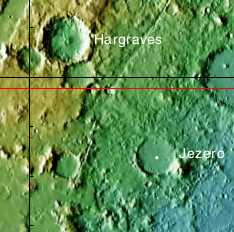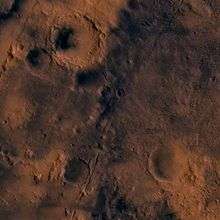Jezero (crater)
 Jezero crater and region (USGS) | |
| Planet | Mars |
|---|---|
| Coordinates | 18°51′18″N 77°31′08″E / 18.855°N 77.519°ECoordinates: 18°51′18″N 77°31′08″E / 18.855°N 77.519°E |
| Diameter | 49.0 km (30.4 mi) |
| Eponym | Jezero, meaning "lake" in Slavic languages |
Jezero is a crater on Mars located at 18°51′18″N 77°31′08″E / 18.855°N 77.519°E[1] in the Syrtis Major quadrangle. The diameter of the crater is about 49.0 km (30.4 mi). Thought to have once been flooded with water, the crater contains a fan-delta deposit rich in clays.[2]
In several Slavic languages, including Bosnian, Croatian, Czech, Serbian, Slovak and Slovene, the word jezero means "lake".
Mars 2020 mission

Jezero crater, once considered a site for the Mars Science Laboratory, is a proposed landing site for the Mars 2020 rover mission.[3][4] In the second Mars 2020 Landing Site Workshop it survived the cut and was named to be among the top 8 sites still in the running for the landing.[5] Life may have developed in the crater since it is believed the lake was long-lived; the delta may have required period of 106 –107 years to form.[6] Clay minerals have been detected in and around the crater.[7][8][9] The Mars Reconnaissance Orbiter identified smectite clays.[10] Clays form in the presence of water, so this area probably once held water and maybe life in ancient times. The surface in places are cracked into polygonal patterns. Such shapes often form when clay dries out. These patterns can be seen in the image below. The image shows a channel that carried water and sediments into Jezero crater.[1]
Researchers described in a paper, released in March 2015, how an ancient Martian lake system existed in Jezero Crater. The study advanced the idea that water filled the crater at least two separate times.[11] There are two channels on the northern and western sides of the crater that probably supplied it with water; both of these channels have delta-like deposit where sediment was carried by water and deposited in the lake.[12] Craters of a given diameter are expected to have a certain depth; a depth less than expected means sediment has entered the crater.[13] Calculations suggest that the crater may hold about one kilometer of sediments. Most of the sediments may have been brought in by channels.[6] A primary aim of the Mars 2020 mission is to search for signs of ancient life. It is hoped that a later mission could then return samples from sites identified as probably containing remains of life. To safely bring the craft down, a 12-mile wide, smooth, flat circular area is needed. Geologists hope to examine places where water once ponded.[14] They would like to examine sediment layers.
See also
References
- 1 2 Wray, James (6 June 2008). "Channel into Jezero Crater Delta". NASA. Retrieved 6 March 2015.
- ↑ Prime landing sites chosen for biggest Martian rover - space - 2 November 2007 - New Scientist Space
- ↑ Staff (4 March 2015). "PIA19303: A Possible Landing Site for the 2020 Mission: Jezero Crater". NASA. Retrieved 7 March 2015.
- ↑ http://marsoweb.nas.nasa.gov/landingsites/msl/workshops/2nd_workshop/talks/Fassett_Nili.pdf
- ↑ Golombek, J. et al. 2016. Downselection of landing Sites for the Mars 2020 Rover Mission. 47th Lunar and Planetary Science Conference (2016). 2324.pdf
- 1 2 Schon, S., J. Head, C. Fassett. 2012. An overfilled lacustrine system and progradational delta in Jezero crater, Mars: Implications for Noachian climate. Planetary and Space Science: 67, 28–45
- ↑ Bibring, J. et al. 2006. Global mineralogical and aqueous Mars history derived from OMEGA/Mars Express data. Science: 312, 400-404.
- ↑ Mangold, N., et al. 2007. Mineralogy of the Nili Fossae region with OMEGA/Mars Express data: 2. Aqueous alteration of the crust. Journal of Geophysical Research 112, E08S04. doi:10.1029/2006JE002835.
- ↑ Poulet, F., et al. 2005. Phyllosilicates on Mars and implications for early martian climate. Nature, 438. doi:10.1038/nature04274.
- ↑ Murchie, S.; et al. (2009). "A synthesis of Martian aqueous mineralogy after 1 Mars year of observations from the Mars Reconnaissance Orbiter". Journal of Geophysical Research. 114 (E2). doi:10.1029/2009JE003342. Retrieved 7 March 2015.
- ↑ http://www.sciencedaily.com/releases/2015/03/150325210744.htm
- ↑ http://spaceref.com/mars/ancient-martian-lake-system-records-two-water-related-events.html
- ↑ Garvin, J., S. Sakimoto, J. Frawley. 2003. Craters on Mars: Global geometric properties from gridded MOLA topography. In: Sixth International Conference on Mars. Abstract no. #3277
- ↑ Staff (2010). "The Floods of Iani Chaos". NASA. Retrieved 7 March 2015.
Further reading
- Ehlmann, B.L.; Mustard, John F.; Fassett, Caleb I.; Schon, Samuel C.; Head Iii, James W.; Des Marais, David J.; Grant, John A.; Murchie, Scott L. (2008). "Clay minerals in delta deposits and organic preservation potential on Mars". Nature Geoscience. 1 (6): 355–358. Bibcode:2008NatGe...1..355E. doi:10.1038/ngeo207.
- Schon; et al. (2008). Meander Loops and Point Bar Sequences - Evidence of a Stable Delta Plain Environment in Jezero crater (PDF). Lunar and Planetary Sciences conference.
